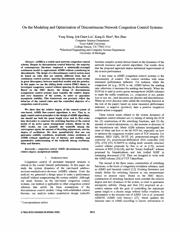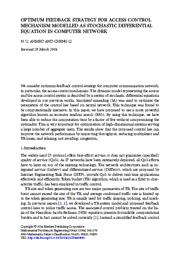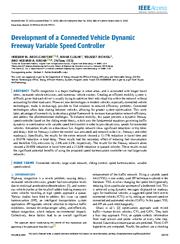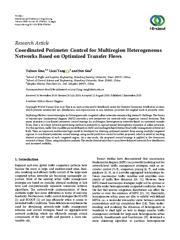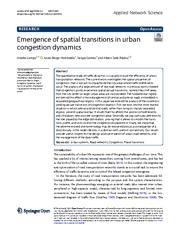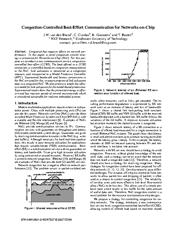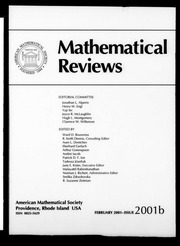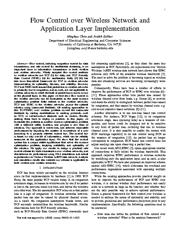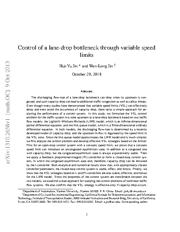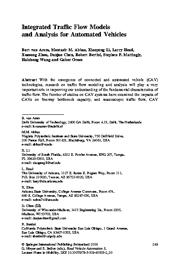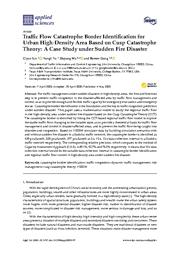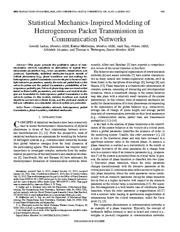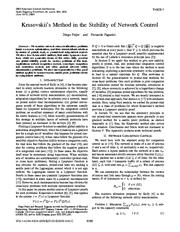A copy of this work was available on the public web and has been preserved in the Wayback Machine. The capture dates from 2017; you can also visit the original URL.
The file type is application/pdf.
Filters
On the modeling and optimization of discontinuous network congestion control systems
IEEE INFOCOM 2004
The design of a discontinuous control system must be based on rules that are entirely different from that of continuous control systems. ...
This framework can precisely reflect the behavior of the control rules and the contmlled objective of a congestion control system. ...
ACKNOWLEooMENT The work reported in this paper is supported in part by the National Science Foundation, contract number EIA-0081761. The financial support of NSF is achowledged. ...
doi:10.1109/infcom.2004.1354698
dblp:conf/infocom/XiongLSZ04
fatcat:mnkxescxe5f6tlrmtg373njwqq
Congestion phenomena on complex networks
2009
Physical Review E
Traffic control also introduces non-linear effects and, beyond a critical strength, may trigger the appearance of a congested phase in a discontinuous manner. ...
We define a minimal model of traffic flows in complex networks containing the most relevant features of real routing schemes, i.e. a trade--off strategy between topological-based and traffic-based routing ...
Congestion avoidance and control are performed by continuously updating the dynamics of end-to-end flows in response to the variation of the load level in the network. ...
doi:10.1103/physreve.79.015101
pmid:19257095
fatcat:ywfx5y7qmzcjbmjpmuexfasofa
Optimum feedback strategy for access control mechanism modelled as stochastic differential equation in computer network
2004
Mathematical Problems in Engineering
The dynamic model representing the source and the access control system is described by a system of stochastic differential equations developed in our previous works. ...
Simulated annealing (SA) was used to optimize the parameters of the control law based on neural network. This technique was found to be computationally intensive. ...
Acknowledgment This work was partially supported by the National Science and Engineering Research Council of Canada under Grant A7109. ...
doi:10.1155/s1024123x04403081
fatcat:q2pnlzbubrhb7oluvnwwvvzd4u
Development of a Connected Vehicle Dynamic Freeway Sliding Mode Variable Speed Controller
2020
IEEE Access
These results reveal the significant potential benefits of using the proposed speed harmonization controller on real large-scale networks. ...
Simulation results on a downtown Los Angeles network show significant reductions in trip times and delays both on freeways (where the control was activated) and network-wide (i.e., freeways and other roadways ...
The authors transformed the nonlinear model to a linear model to reduce system complexity, and found dynamic optimal advisory speed limits for the case study network. ...
doi:10.1109/access.2020.2995552
fatcat:ztfqekgrwbfolaffae7zg3ihxu
Coordinated Perimeter Control for Multiregion Heterogeneous Networks Based on Optimized Transfer Flows
2020
Mathematical Problems in Engineering
The theory of macroscopic fundamental diagram (MFD) provides a new perspective for network-wide congestion control decisions. ...
This paper proposes a coordinated perimeter control strategy for multiregion heterogeneous networks based on optimized transfer flows. ...
On the whole, the fixed signal control lacks the optimal control of network traffic flows, which causes the oversaturation of three congested regions and even gridlocks of road network; the decentralized ...
doi:10.1155/2020/3926265
fatcat:lspbg62xr5hmrkm4aoxaoibbfy
Emergence of spatial transitions in urban congestion dynamics
2021
Applied Network Science
Our results provide useful insights for the design and optimization of urban road networks, and the management of the daily traffic. ...
Secondly, we pay particular attention to the role played by the edge distribution, proving that it allows to smooth the transitions profile, and so to control the congestion displacement. ...
Availability of data and materials The codes used during the current study are available from the corresponding author on reasonable request. ...
doi:10.1007/s41109-021-00383-6
fatcat:7pi6gc2kavh4blmuqx4w53ilxm
Congestion-Controlled Best-Effort Communication for Networks-on-Chip
2007
2007 Design, Automation & Test in Europe Conference & Exhibition
Congestion has negative effects on network performance. In this paper, a novel congestion control strategy is presented for Networks-on-Chip (NoC). ...
The load offered to a CCBE connection is controlled based on congestion measurements in the NoC. ...
This is one of the costs of the proposed congestion control method as further explained in Section 4.
Network model MPC uses a model of the controlled system to iteratively compute future behavior. ...
doi:10.1109/date.2007.364415
dblp:conf/date/BrandCGB07
fatcat:knsbowixejd63pxkmkt75qodii
Page 1431 of Mathematical Reviews Vol. , Issue 2001B
[page]
2001
Mathematical Reviews
A rate that is too high may result in congestion and hence in the degradation of performance measures: high delays within the network, high loss probabilities of information pack- ets, and large delay ...
This paper reviews the convergence of methodologies for nonlinear model predictive control, assesses the challenges arising from uncertainty and from non-convexity of the optimal control problem, and attempts ...
Antifragile Control Systems: The case of an oscillator-based network model of urban road traffic dynamics
[article]
2023
arXiv
pre-print
In our work, we consider a novel system for road traffic control based on a network of interacting oscillators. ...
In this study, we propose a new realization of the antifragile control framework to control a network of interacting oscillator-based traffic light models to achieve region-level flow optimization. ...
In our case, the network of coupled oscillators is a system with discontinuous control (i.e. the control law u i (t) uses the sign of the energy surplus to drive the system towards the antifragile dynamics ...
arXiv:2210.10460v3
fatcat:bfhuxzev4vdp7c3flhlvnnzil4
Flow Control Over Wireless Network and Application Layer Implementation
2006
Proceedings IEEE INFOCOM 2006. 25TH IEEE International Conference on Computer Communications
We show that the control system has a unique stable equilibrium that solves the concave optimization problem, implying scalability and optimality of the solution. ...
The control law is based on only one bit of information, which can be reliably measured at the application layer. ...
ACKNOWLEDGEMENT The authors would like to express their thanks to Alessandro Abate and Shankar Sastry for helpful discussions and help in preparing the paper. ...
doi:10.1109/infocom.2006.186
dblp:conf/infocom/ChenZ06
fatcat:hjoyjmjbfzatte2scn5g2h26d4
Control of a lane-drop bottleneck through variable speed limits
[article]
2013
arXiv
pre-print
Since the properties of the control system are transferable between the two models, we establish a dual approach for studying the control problems of nonlinear traffic flow systems. ...
Since the link queue model approximates the LWR model and is much simpler, we first analyze the control problem and develop effective VSL strategies based on the former. ...
., 2005) , network-wide coordination of VSL and ramp metering was studied within the framework of model predictive control based on a higher-order simulation model. ...
arXiv:1310.2658v1
fatcat:qkubgioginhmtnsxjnyu2ek5fe
Integrated Traffic Flow Models and Analysis for Automated Vehicles
[chapter]
2016
Lecture Notes in Mobility
The frontier of studies on CAV systems have examined the impacts of CAVs on freeway bottleneck capacity, and macroscopic traffic flow, CAV 249 applications on optimization of individual vehicle trajectories ...
, potentials of CAV in traffic signal control, and applications of CAV in network routing. ...
The remaining sections of this paper are organized as follows: Sect. 2 presents the summary of the invited presentations and Sect. 3 introduces the key results from the panel discussion. ...
doi:10.1007/978-3-319-40503-2_20
fatcat:65cf32clxve6hlr35qqqnilo6m
Traffic Flow Catastrophe Border Identification for Urban High-Density Area Based on Cusp Catastrophe Theory: A Case Study under Sudden Fire Disaster
2020
Applied Sciences
flow management and control in disaster-affected areas, and to prevent the traffic flow being caught into disorder and congestion. ...
For traffic management under sudden disasters in high-density areas, the first and foremost step is to prevent traffic congestion in the disaster-affected area by traffic flow management and control, so ...
Acknowledgments: We are very thankful to the reviewers for their time and efforts, their comments and suggestions have greatly improved the quality of this paper. ...
doi:10.3390/app10093197
fatcat:t67i4xd62fhfzmnd2t3y3fqgpi
Statistical Mechanics-Inspired Modeling of Heterogeneous Packet Transmission in Communication Networks
2012
IEEE Transactions on Systems Man and Cybernetics Part B (Cybernetics)
In this context, decision functions and control objectives are derived in closed forms, and the pertinent results of test and validation on a simulated network system are presented. ...
, namely, the external packet load on the network system and the packet transmission probabilities of heterogeneous packet types. ...
Network Congestion Modeled as a Phase Transition Congestion is a phenomenon of significant importance in communication networks. ...
doi:10.1109/tsmcb.2012.2186611
pmid:22411024
fatcat:jrsielgwxfekljalsji6sioo3e
Krasovskii's method in the stability of network control
2009
2009 American Control Conference
We consider network resource allocation problems based on convex optimization, and their decentralized solutions by means of primal, dual, or primal-dual subgradient control. ...
Applications include congestion control, cross-layer congestion and contention control, and other general network utility maximization problems. ...
CONCLUSIONS We studied network optimization problems from congestion control and extensions to cross-layer optimization. ...
doi:10.1109/acc.2009.5160529
dblp:conf/amcc/FeijerP09
fatcat:jvplgo3azbhvdcjt3ejdqt5oyi
« Previous
Showing results 1 — 15 out of 12,282 results

